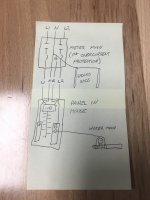newservice
Senior Member
Um,...yeah when its replaced with pvc then it isn't a metal underground water pipe any more. we were talking about underground metal water pipes?One rod with the water pipe is not good enough because in some places the metal water pipe is replaced with a nonmetallic pipe and then according to the NEC the single untested rod is not good enough.
If that isn't good enough I can show you a whole city of houses that for the last 50 years only have 1 ground rod, thats why they didnt put your exception in the code maybe


